Mikolaj Kegler
CATSE: A Context-Aware Framework for Causal Target Sound Extraction
Mar 21, 2024



Abstract:Target Sound Extraction (TSE) focuses on the problem of separating sources of interest, indicated by a user's cue, from the input mixture. Most existing solutions operate in an offline fashion and are not suited to the low-latency causal processing constraints imposed by applications in live-streamed content such as augmented hearing. We introduce a family of context-aware low-latency causal TSE models suitable for real-time processing. First, we explore the utility of context by providing the TSE model with oracle information about what sound classes make up the input mixture, where the objective of the model is to extract one or more sources of interest indicated by the user. Since the practical applications of oracle models are limited due to their assumptions, we introduce a composite multi-task training objective involving separation and classification losses. Our evaluation involving single- and multi-source extraction shows the benefit of using context information in the model either by means of providing full context or via the proposed multi-task training loss without the need for full context information. Specifically, we show that our proposed model outperforms size- and latency-matched Waveformer, a state-of-the-art model for real-time TSE.
Latent CLAP Loss for Better Foley Sound Synthesis
Mar 18, 2024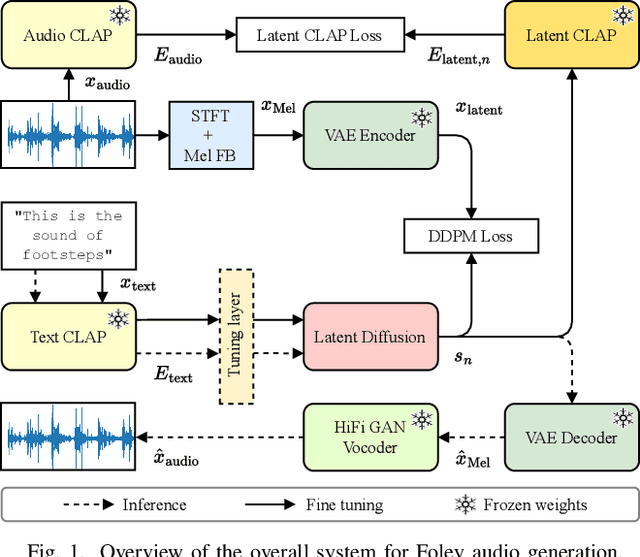
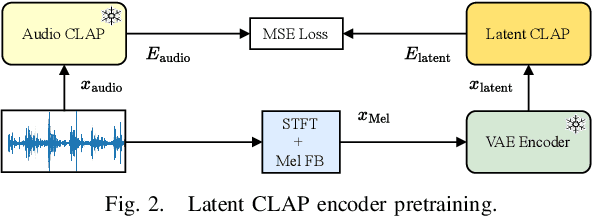
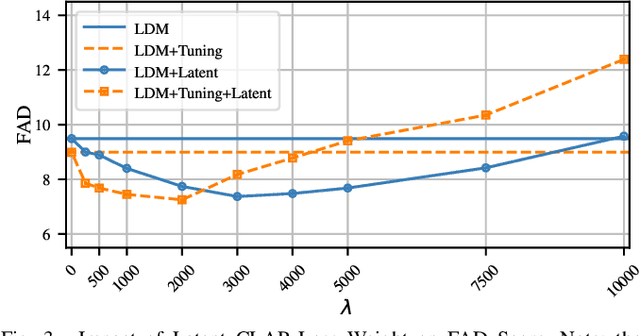

Abstract:Foley sound generation, the art of creating audio for multimedia, has recently seen notable advancements through text-conditioned latent diffusion models. These systems use multimodal text-audio representation models, such as Contrastive Language-Audio Pretraining (CLAP), whose objective is to map corresponding audio and text prompts into a joint embedding space. AudioLDM, a text-to-audio model, was the winner of the DCASE2023 task 7 Foley sound synthesis challenge. The winning system fine-tuned the model for specific audio classes and applied a post-filtering method using CLAP similarity scores between output audio and input text at inference time, requiring the generation of extra samples, thus reducing data generation efficiency. We introduce a new loss term to enhance Foley sound generation in AudioLDM without post-filtering. This loss term uses a new module based on the CLAP mode-Latent CLAP encode-to align the latent diffusion output with real audio in a shared CLAP embedding space. Our experiments demonstrate that our method effectively reduces the Frechet Audio Distance (FAD) score of the generated audio and eliminates the need for post-filtering, thus enhancing generation efficiency.
Two-Step Knowledge Distillation for Tiny Speech Enhancement
Sep 15, 2023Abstract:Tiny, causal models are crucial for embedded audio machine learning applications. Model compression can be achieved via distilling knowledge from a large teacher into a smaller student model. In this work, we propose a novel two-step approach for tiny speech enhancement model distillation. In contrast to the standard approach of a weighted mixture of distillation and supervised losses, we firstly pre-train the student using only the knowledge distillation (KD) objective, after which we switch to a fully supervised training regime. We also propose a novel fine-grained similarity-preserving KD loss, which aims to match the student's intra-activation Gram matrices to that of the teacher. Our method demonstrates broad improvements, but particularly shines in adverse conditions including high compression and low signal to noise ratios (SNR), yielding signal to distortion ratio gains of 0.9 dB and 1.1 dB, respectively, at -5 dB input SNR and 63x compression compared to baseline.
Self-Supervised Learning for Speech Enhancement through Synthesis
Nov 04, 2022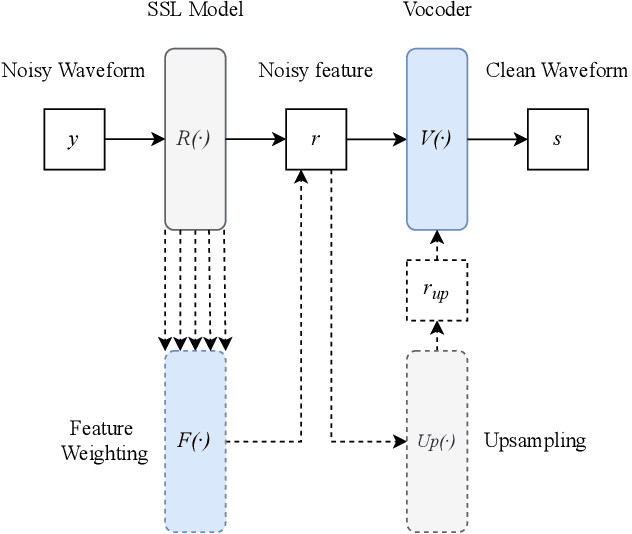
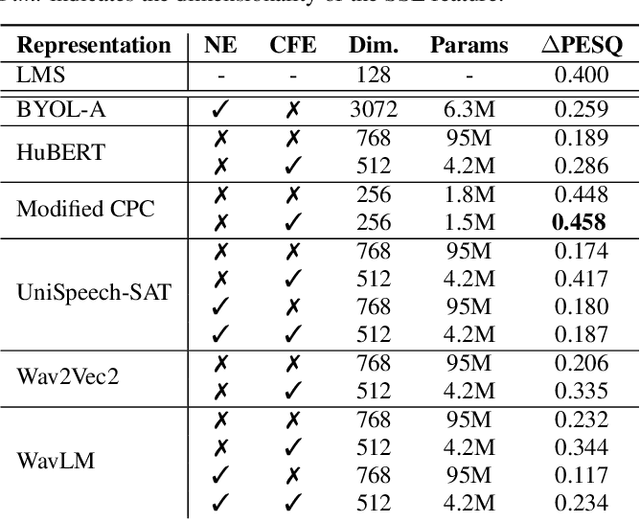
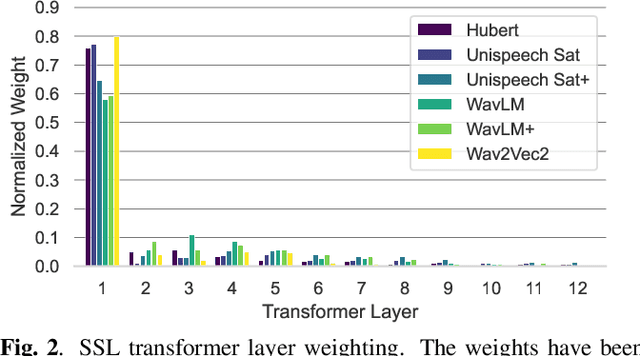

Abstract:Modern speech enhancement (SE) networks typically implement noise suppression through time-frequency masking, latent representation masking, or discriminative signal prediction. In contrast, some recent works explore SE via generative speech synthesis, where the system's output is synthesized by a neural vocoder after an inherently lossy feature-denoising step. In this paper, we propose a denoising vocoder (DeVo) approach, where a vocoder accepts noisy representations and learns to directly synthesize clean speech. We leverage rich representations from self-supervised learning (SSL) speech models to discover relevant features. We conduct a candidate search across 15 potential SSL front-ends and subsequently train our vocoder adversarially with the best SSL configuration. Additionally, we demonstrate a causal version capable of running on streaming audio with 10ms latency and minimal performance degradation. Finally, we conduct both objective evaluations and subjective listening studies to show our system improves objective metrics and outperforms an existing state-of-the-art SE model subjectively.
BYOL-S: Learning Self-supervised Speech Representations by Bootstrapping
Jun 30, 2022



Abstract:Methods for extracting audio and speech features have been studied since pioneering work on spectrum analysis decades ago. Recent efforts are guided by the ambition to develop general-purpose audio representations. For example, deep neural networks can extract optimal embeddings if they are trained on large audio datasets. This work extends existing methods based on self-supervised learning by bootstrapping, proposes various encoder architectures, and explores the effects of using different pre-training datasets. Lastly, we present a novel training framework to come up with a hybrid audio representation, which combines handcrafted and data-driven learned audio features. All the proposed representations were evaluated within the HEAR NeurIPS 2021 challenge for auditory scene classification and timestamp detection tasks. Our results indicate that the hybrid model with a convolutional transformer as the encoder yields superior performance in most HEAR challenge tasks.
Hybrid Handcrafted and Learnable Audio Representation for Analysis of Speech Under Cognitive and Physical Load
Mar 30, 2022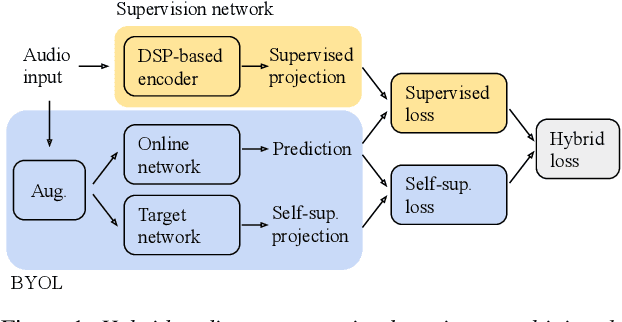

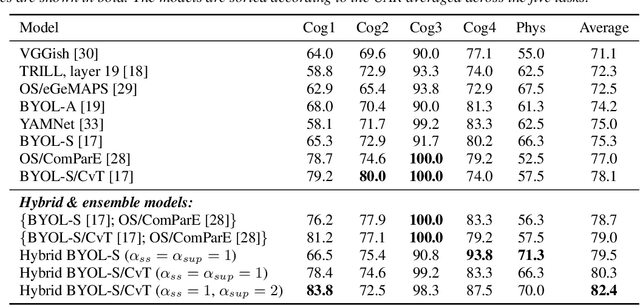
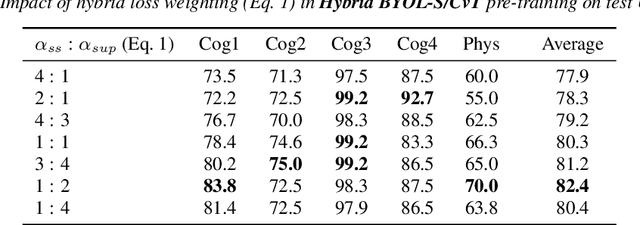
Abstract:As a neurophysiological response to threat or adverse conditions, stress can affect cognition, emotion and behaviour with potentially detrimental effects on health in the case of sustained exposure. Since the affective content of speech is inherently modulated by an individual's physical and mental state, a substantial body of research has been devoted to the study of paralinguistic correlates of stress-inducing task load. Historically, voice stress analysis (VSA) has been conducted using conventional digital signal processing (DSP) techniques. Despite the development of modern methods based on deep neural networks (DNNs), accurately detecting stress in speech remains difficult due to the wide variety of stressors and considerable variability in the individual stress perception. To that end, we introduce a set of five datasets for task load detection in speech. The voice recordings were collected as either cognitive or physical stress was induced in the cohort of volunteers, with a cumulative number of more than a hundred speakers. We used the datasets to design and evaluate a novel self-supervised audio representation that leverages the effectiveness of handcrafted features (DSP-based) and the complexity of data-driven DNN representations. Notably, the proposed approach outperformed both extensive handcrafted feature sets and novel DNN-based audio representation learning approaches.
SERAB: A multi-lingual benchmark for speech emotion recognition
Oct 07, 2021
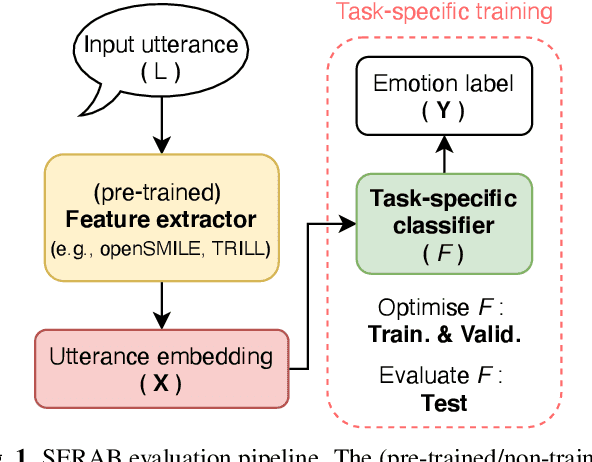
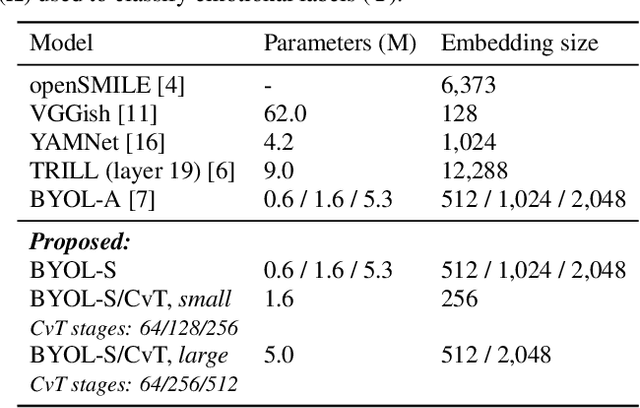
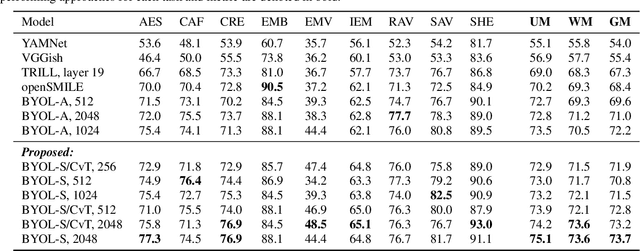
Abstract:Recent developments in speech emotion recognition (SER) often leverage deep neural networks (DNNs). Comparing and benchmarking different DNN models can often be tedious due to the use of different datasets and evaluation protocols. To facilitate the process, here, we present the Speech Emotion Recognition Adaptation Benchmark (SERAB), a framework for evaluating the performance and generalization capacity of different approaches for utterance-level SER. The benchmark is composed of nine datasets for SER in six languages. Since the datasets have different sizes and numbers of emotional classes, the proposed setup is particularly suitable for estimating the generalization capacity of pre-trained DNN-based feature extractors. We used the proposed framework to evaluate a selection of standard hand-crafted feature sets and state-of-the-art DNN representations. The results highlight that using only a subset of the data included in SERAB can result in biased evaluation, while compliance with the proposed protocol can circumvent this issue.
Speech-VGG: A deep feature extractor for speech processing
Oct 22, 2019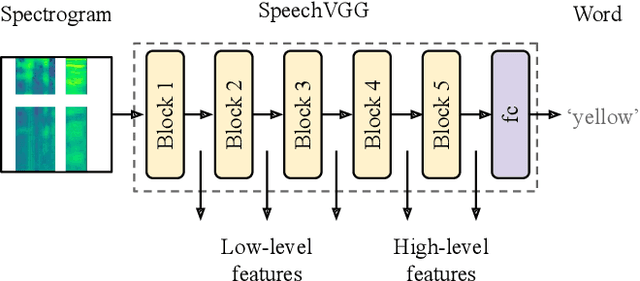
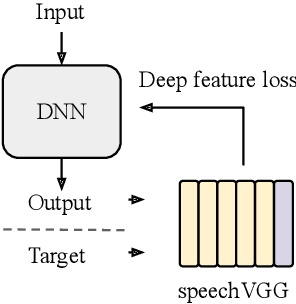

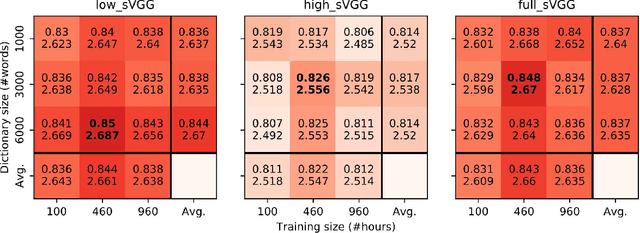
Abstract:A growing number of studies in the field of speech processing employ feature losses to train deep learning systems. While the application of this framework typically yields beneficial results, the question of what's the optimal setup for extracting transferable speech features to compute losses remains underexplored. In this study, we extend our previous work on speechVGG, a deep feature extractor for training speech processing frameworks. The extractor is based on the classic VGG-16 convolutional neural network re-trained to identify words from the log magnitude STFT features. To estimate the influence of different hyperparameters on the extractor's performance, we applied several configurations of speechVGG to train a system for informed speech inpainting, the context-based recovery of missing parts from time-frequency masked speech segments. We show that changing the size of the dictionary and the size of the dataset used to pre-train the speechVGG notably modulates task performance of the main framework.
Deep speech inpainting of time-frequency masks
Oct 22, 2019
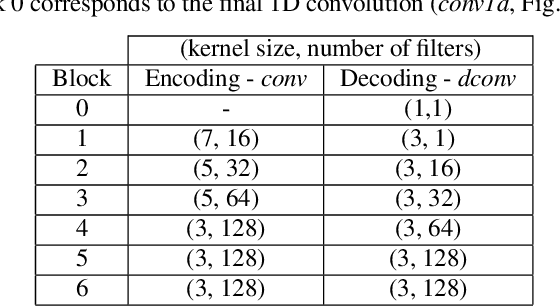
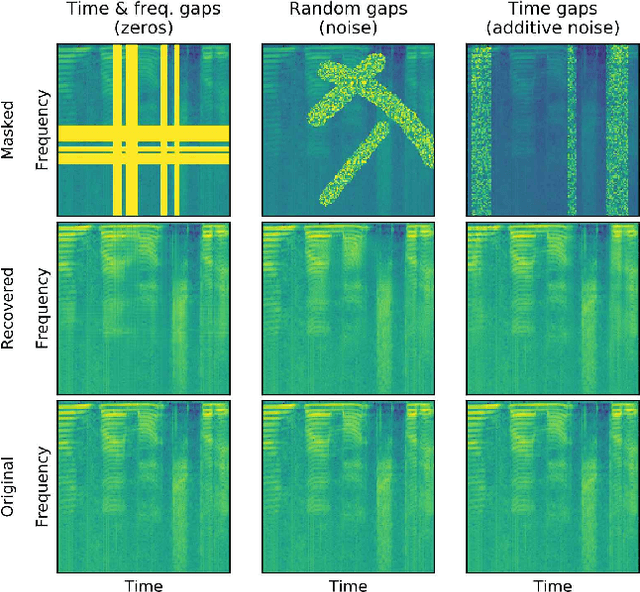

Abstract:In particularly noisy environments, transient loud intrusions can completely overpower parts of the speech signal, leading to an inevitable loss of information. Recent algorithms for noise suppression often yield impressive results but tend to struggle when the signal-to-noise ratio (SNR) of the mixture is low or when parts of the signal are missing. To address these issues, here we introduce an end-to-end framework for the retrieval of missing or severely distorted parts of time-frequency representation of speech, from the short-term context, thus speech inpainting. The framework is based on a convolutional U-Net trained via deep feature losses, obtained through speechVGG, a deep speech feature extractor pre-trained on the word classification task. Our evaluation results demonstrate that the proposed framework is effective at recovering large portions of missing or distorted parts of speech. Specifically, it yields notable improvements in STOI & PESQ objective metrics, as assessed using the LibriSpeech dataset.
 Add to Chrome
Add to Chrome Add to Firefox
Add to Firefox Add to Edge
Add to Edge